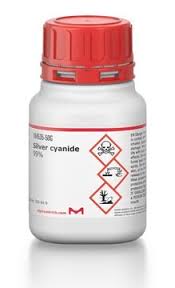silver cyanide formula
Basic Properties of Silver Cyanide
Silver cyanide is a unique compound that plays a key role in various industrial and chemical applications. Its defined chemical structure, physical properties, and manufacturing methods all contribute to its importance, especially in electroplating. Let’s dive deeper into some of the core aspects that define this compound.
Chemical Formula and Structure
The chemical formula for silver cyanide is AgCN, illustrating its composition:
- Ag: The element silver, a noble metal known for its conductivity and antibacterial properties.
- C: Carbon, a vital element found in organic and inorganic compounds.
- N: Nitrogen, commonly associated with cyanide functionality in this compound.
In silver cyanide, the silver (Ag) atom is bonded ionically to the cyanide group (CN). Structurally, the compound consists of a linear molecule, as the cyanide ion forms a covalent bond between carbon and nitrogen, with the silver ion linking to this group. This arrangement gives silver cyanide its characteristic chemical behaviour. For more details, visit PubChem’s resource on silver cyanide.
Physical and Chemical Characteristics
Silver cyanide is easily recognised by its distinct properties:
- Appearance: It typically forms a white to grey odourless powder, though it may darken when exposed to light.
- Solubility: It is largely insoluble in water, making it stable under standard conditions. However, it dissolves in solutions containing ammonia or potassium cyanide, suggesting its reactivity in specific environments.
- Stability: Though stable in normal conditions, it decomposes rapidly under acidic conditions, producing hydrogen cyanide gas—a highly toxic and flammable substance. This warrants careful handling.
- Reactivity: Silver cyanide plays a major role in silver plating by undergoing chemical reactions to deposit metallic silver on surfaces. According to Sigma-Aldrich, its decomposition temperature is around 320°C.
These unique characteristics make silver cyanide highly valuable across specific industries while still requiring caution in usage.

Occurrence and Sources
Silver cyanide is not typically found in nature. Instead, it is synthetically manufactured, especially for industrial purposes. The process often involves reacting silver salts, such as silver nitrate, with cyanide salts like sodium or potassium cyanide. This generates silver cyanide as a precipitate.
Industrially, its production often aligns with its utilisation in processes like electroplating or extraction of metals from ores. Such applications make it a common asset in factories and laboratories but not something encountered outside controlled settings. More information about its occurrence and production can be found through Wikipedia’s detailed entry on silver cyanide.
Understanding these foundational properties of silver cyanide shines light on why it is highly valued for industrial use while also highlighting the need for proper safety measures in handling.
Uses and Applications of Silver Cyanide
Silver cyanide is a compound known for its versatility in various industries. From promoting lustrous metallic finishes to contributing to specialised industrial processes, its applications are wide-ranging and indispensable. Let’s explore where and how silver cyanide plays a vital role.
Role in Electroplating
Electroplating, a process that coats a metal surface with a thin layer of another metal, heavily relies on silver cyanide, especially for silver plating. This compound is used extensively due to its high efficiency in transferring silver ions to the object being plated.
Silver cyanide acts as a source of silver ions and facilitates smooth and uniform deposition, resulting in shiny and durable coatings. It is often included in solutions like potassium or sodium cyanide to form a stable plating bath. These baths are ideal for industries looking to achieve a polished, corrosion-resistant finish on metals such as copper or brass.
For example, silver-plated objects, such as cutlery or electrical connectors, benefit from silver cyanide’s unique chemical properties, providing them with enhanced conductivity and resistance to oxidation. For more technical insights into its use, check out Why is Silver Cyanide Used for Electroplating.
Applications in Jewellery and Ornamentation
The jewellery industry depends on silver cyanide for its electroplating solutions, ensuring precious ornaments retain their shine and appeal for years. The compound is used to create a thin layer of silver on base metals like nickel or copper, producing cost-effective yet luxurious-looking jewellery.
Moreover, silver plating through cyanide-based solutions allows jewellers to manufacture custom designs while saving on raw material costs. Whether crafting intricate necklaces, bracelets, or decorative items, silver cyanide ensures every piece is both elegant and durable.
This technique is not limited to high-end jewellery. Even decorative pieces like candlesticks, charms, and tableware are treated with silver cyanide-based solutions. For further reading on how silver is utilised in jewellery, visit The Use of Cyanide in Jewellery.
Other Industrial Uses
- Photography: Historically, silver cyanide found its way into photographic processes as part of the silver halide development systems. Though modern methods have evolved, its role in early photography laid the groundwork for imaging technologies.
- Organic Synthesis: In chemical processes, silver cyanide serves as a catalyst or reagent in organic synthesis, aiding in creating complex organic molecules.
- Specialised Coatings and Finishes: Aside from electroplating, silver cyanide’s stability and reactivity make it ideal for niche industrial operations requiring precise surface coatings.
- Laboratory Applications: Chemists also utilise silver cyanide in analytical procedures, owing to its interactions with light and metallic compounds. Learn more about its diverse industrial applications at Silver Cyanide Identified Uses.
These applications highlight the compound’s adaptability, cementing its place in various industries beyond traditional silver plating.






